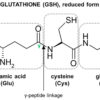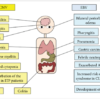Vitamin A is a group of biologically active, fat-soluble molecules that includes retinol, retinal, and retinoic acid.
These compounds are derived from the plant precursor molecule beta-carotene, which is converted to vitamin A by intestinal absorptive cells and hepatocytes. Vitamin A is stored in the liver and transported to extrahepatic tissues. It is essential for a number of physiological processes, including vision, organogenesis, tissue differentiation, immune function, reproduction, embryonic development, and maintenance of healthy skin and barrier functions. Vitamin A deficiency can manifest as night blindness, xerophthalmia, follicular hyperkeratosis, increased susceptibility to infection, and anemia. Vitamin A toxicity can occur when excessive levels are consumed and can lead to symptoms such as dizziness, nausea, vomiting, headaches, blurred vision, and vertigo.
Use
Diagnosis of hypervitaminosis A. Low serum carotene level and a low vitamin A suggests vitamin A deficiency.
Methodology
Liquid chromatography/tandem mass spectrometry (LC/MS-MS)



